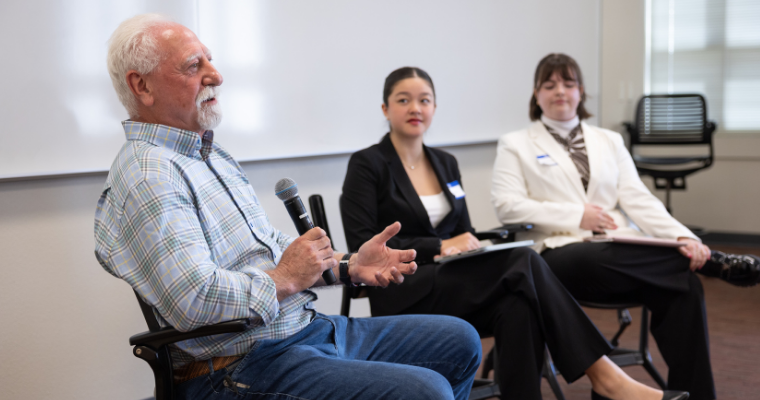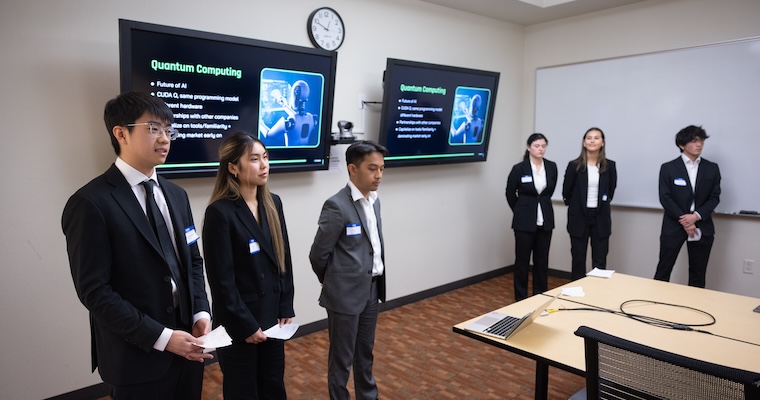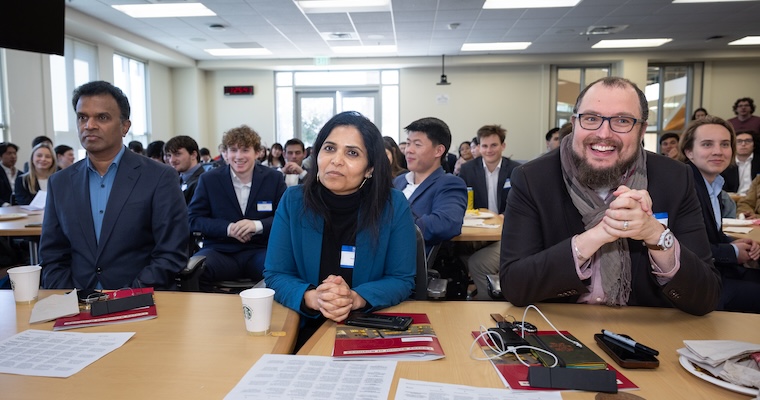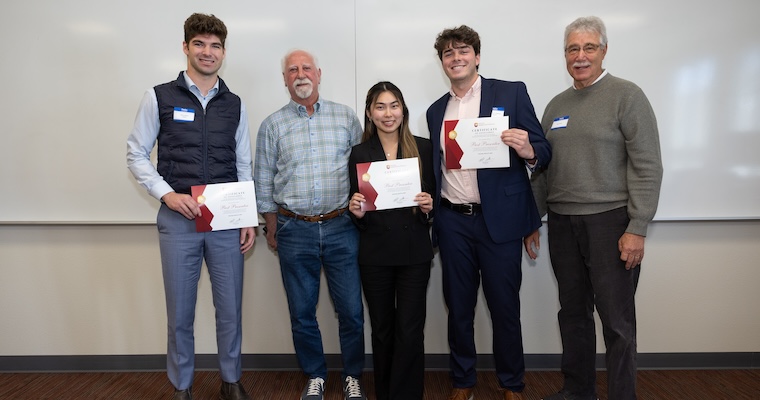
NVIDIA Co-founder Addresses Students at the 3rd Annual International Business Case Challenge Competition
Standing in front of a room packed full of Leavey School of Business students, NVIDIA co-founder and Santa Clara engineering graduate Chris Malachowsky admitted he was a little envious.
During his education, he told them, he never had the chance to study and learn from how other companies launched, evolved and succeeded. Then again, things worked out well for NVIDIA, a leader in graphics processing, computing and related technology with headquarters nearby in Santa Clara.
“The path is not straight, and the challenges are not predictable,” Malachowsky told the students, who were gathered for the third annual International Business Case Challenge Competition. “So maybe by following our history and the other studies that I’ve heard you’ve done, you’ll be a little more prepared to navigate some of those waters when it’s your turn.”
The students were there to navigate those waters, at least in simulated form. Working in eight six-person teams drawn from two courses in international business, they quickly got their own chance at the podium. Each team presented their respective portions of a deep dive into NVIDIA’s business and its related challenges. In front of two panels of esteemed judges, they covered everything from the changing supply chain for computer chips to an ever-shifting regulatory environment to trends in manufacturing and production.
Making the Case
Importantly, Long Le, associate teaching professor and one of the event organizers, along with Vahideh Abaeian and Ihsen Ketata Aref, says student work began long before the actual day of the competition. “It's not enough just to engage in the case study,” Le says. “We wanted to empower them with the ability to actually write the case study.”
So, to prepare for the case competition, Le enlisted students in the Leavey Scholars program. These students had the opportunity to interview NVIDIA SVP and Leavey graduate Jeff Fisher for foundational background that, along with additional research, would form the in-depth case study: “Syrup, Silicon, and Success: NVIDIA’s Rise from Denny’s to Dominance.”
The case study, completed rigorously in a matter of weeks, explores NVIDIA’s origin story in a Denny’s diner booth — hence the syrup reference. It then explores how leadership has guided the company through several phases, from dominance in the graphics processing unit (GPU) market to evolving new fields and markets such as the modern AI boom.
Le saw firsthand the way students learned and adapted as they worked on the study, during a process that very much mimics what they’ll face in a collaborative work environment in the future.
“Each team has a subsection that they have to write about,” he says. “But they also really had to care about the whole product of the case study. They had to be able to read and analyze other sections and be OK with looking at their own section and saying, ‘There’s a conflict here. I need to take this out.’ They had to think about the story they were telling as a whole.”
High Stakes, High Stress
The students who created the case study got one form of real world experience, and the students who reacted to it got another.
For competition day, each team received the case study with a mere 24-hours to prepare to present. This high-stakes approach mimics another reality of the business world: Things happen fast.
“For the students who participate in the competition, the idea is that sometimes in the workplace you're thrown into a project, and you have 24 hours or so to figure it out. You have to work with people you don't necessarily know or haven’t worked with. It's a very challenging situation, but at the same time we also provide them support because we want them to succeed.”
The team that won the competition — consisting of Warren Ngantung, Tatum Anderson, Andre Gaviola, Youki Imai, Emily Han and Caroline Berman — succeeded by focusing on a few pressing and current issues. For instance, they discussed reliance on Taiwanese semiconductor manufacturing and possible alternative domestic opportunities created by the bipartisan CHIPS and Science Act of 2022. Other individual students were recognized for their individual prowess as “Best Presenters,” too: Emily Han, Henry Finn McMullen and Rhett LaRocca.
Malachowsky, who astutely told students that “success is not a solo sport,” walked away feeling positive about the future state of business leadership.
“It was impressive to me that the students, in around 24 hours, could learn about us, develop a perspective on opportunities, and both report and defend their positions,” Malachowsky says. “I was impressed with those that saw the opportunities in a historical perspective to look for approaches that we might have a predisposition to pursue.”
Le notes that he and fellow organizers and faculty members Ihsen Ketata Aref and Vahideh Abaeian want the results of all this student effort to live beyond the competition. For example, students will turn portions of the case into videos for peer-to-peer learning. And he plans to pursue peer-reviewed publication for the case study.
For Malachowsky, who was participating in a case competition for the first time, the benefit of such an experience for students is clear. “I am a firm believer that the most impactful people in a modern organization are those with the better communication skills,” he says. “This event put people’s self-confidence, and ability to articulate a position to the test.”


